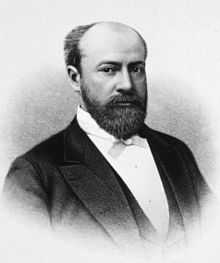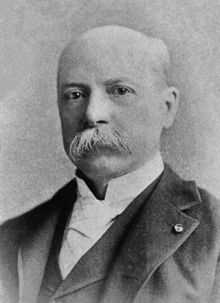Charles Leale



Dr. Charles Augustus Leale M.D. (March 26, 1842 – June 13, 1932) was a surgeon in the Union Army during the American Civil War. He was the first doctor to arrive at the presidential box at Ford's Theatre on April 14, 1865 after John Wilkes Booth fatally shot President Abraham Lincoln in the back of the head with a Philadelphia Deringer pistol.
At the time, Leale was a 23-year-old surgeon in charge of the Wounded Commissioned Officers' Ward at the United States Army General Hospital in Armory Square, Washington, DC.[1] Just six weeks earlier, he'd graduated in medicine from Bellevue Hospital Medical College in New York. He married a daughter of Yonkers, New York industrialist John Copcutt (1805–1895) at the historic John Copcutt Mansion.[2]
A few days before Lincoln's assassination, Leale took a brief break from his exhausting job and took a walk down Pennsylvania Avenue for some fresh air. He noticed a crowd of people heading towards the White House. He discovered Lincoln giving his last public address to the public and was intrigued by the president's facial features. Soon after, Leale learned that Lincoln was going to Ford's Theatre to see the play Our American Cousin. "After completing his duties...Leale changed to civilian clothes and rushed to the Theater, not to see the play, but to study President Lincoln's face and facial expressions."[3] He asked for a seat in the orchestra so he would have an unhindered view, but arrived late and was given a seat in the dress circle (near the front, same side and 40 ft away from the president's box).
There was an interruption in the play when Lincoln arrived. The orchestra played "Hail to the Chief" and the audience gave a standing ovation. Leale could see the full face of the president as he stood only a few aisles behind him.
The play was interrupted once more when John Wilkes Booth jumped down from the presidential box to the stage. Leale stated that Booth "ran to the opposite side of the stage, flourishing in his hand a drawn dagger and vanishing behind the scene." [4] Leale's statement of Booth running across the stage is an enforcer of Michael Kauffman's idea in "American Brutus," that Booth did not break his leg from the fall from the banister instead it was from a fall off of his horse as he fled. [5] Leale, seeing this, immediately rushed to the president's box. When he arrived, he found Lincoln slumped in his armchair supported by Mrs. Lincoln, who was weeping frantically. Leale received permission to take charge. Leale discovered Lincoln paralyzed and struggling to breathe. He laid the president down on the floor and initially thinking that Lincoln had been stabbed in the shoulder, searched for wounds. Finding none, he further detected that Lincoln's eyes were dilated and finally found "a large clot of blood about one inch below the superior curved line and an inch and a half to the left of the median line of the occipital bone in the back of the skull,"[6] that showed that he had been shot. After examining the wound, Leale realized that Lincoln's condition improved if the blood clot was removed, and so continued to release the clot periodically. His assessment of the dire condition of the president ("his wound is mortal; it is impossible for him to recover") was announced to the entire country.
Army surgeon Dr. Charles S. Taft and Dr. Albert F. A. King of Washington then joined Leale and conceded that Lincoln would not survive a carriage ride back to the White House. Leale ordered that Lincoln be moved to the Petersen House across the street so that he could rest in comfort. Leale gave control over the president to the Lincoln family physician, Robert K. Stone, and the commander of the Armory Square Hospital, D. W. Bliss. Lincoln was placed on a bed diagonally, for his 6'4" body was too long to fit lengthwise. He lasped into a coma for approximately nine hours before passing away at 7:22 the next morning.[7] For most of the night, Leale held the president's hand, he was holding it when President Lincoln died, and afterwards said that "sometimes, recognition and reason return just before departure. I held his hand firmly to let him know, in his blindness, that he had a friend." [8]
What was to be a short observation of the president's face turned into nine hours of close doctoring for Charles Leale.
Although Leale submitted a report in 1867 to Representative Benjamin F. Butler's House commission investigating the assassination, Leale's account of Lincoln's death was not publicly revealed until the 100th anniversary of Lincoln's birth in 1909.[9] In that year Leale spoke on "Lincoln's Last Hour" to the New York commandery of the Military Order of the Loyal Legion of the United States.[10] His 1865 written report of 22 pages was thought lost until 2008, when a photocopy of a version available in the Records of the Adjutant General at the National Archives and Records Administration was found in the Georgetown University Library and published.[11]
On June 5, 2012 the Abraham Lincoln Presidential Library and Museum announced that a researcher for The Papers of Abraham Lincoln, Helena Iles Papaioannou, had discovered an 1865 report by Leale in the records of the Surgeon General of the United States, seemingly written just hours after the assassination.[12] The report was in a collection of correspondence received by the Surgeon General at the National Archives. The announcement (which is available online) also includes the full text of Leale's report.[13] Papaioannou discusses the discovery in an All Things Considered interview.[14]
Leale was one of the last surviving attendees of Lincoln's assassination upon his death in 1932.
See also
- Anderson Ruffin Abbott
- Joseph K. Barnes
- Charles H. Crane
- Albert Freeman Africanus King
- Charles Sabin Taft
References
| Wikimedia Commons has media related to Charles Augustus Leale. |
- ↑ Leale, Charles. Lincoln's Last Hours. 1909. Project Gutenberg
- ↑ Neil G. Larson (July 1985). "National Register of Historic Places Registration: John Copcutt Mansion". New York State Office of Parks, Recreation and Historic Preservation. Retrieved 2010-12-24.
- ↑ Helen Leale Harper, "Dr. Charles A Leale: First Surgeon to Reach the Assassinated President Lincoln," Sept 28, 2009 Yonkers Historical Society Newsletter Article
- ↑ http://www.cnn.com/2012/06/07/us/lincoln-document-assasination/
- ↑ American Brutus, Michael Kauffman
- ↑ Richard A. R. Fraser, "How Did Lincoln Die?," American Heritage Magazine February/March 1995 "How Did Lincoln Die?"
- ↑ http://www2.vcdh.virginia.edu/SHD/example.html
- ↑ Jim Bishop, "Abe Lincoln's Last Friend," Reb Acres, 27 December 1977, Sept 27, 2009 Abe Lincoln's Last Friend
- ↑ Charles A. Leale to Benjamin F. Butler, July 20th, 1867, Benjamin Butler Papers, Manuscript Division, Library of Congress, Washington, D.C., box 43
- ↑ Charles A. Leale, Lincoln’s Last Hours: Address Delivered Before the Commandery of the State of New York Military Order of the Loyal Legion of the United States (New York: Privately published, 1909) Project Gutenberg http://www.gutenberg.org/2/4/0/8/24088/ (accessed July 27, 2012)
- ↑ Sotos, JG (2008). The Physical Lincoln Sourcebook. Mount Vernon, VA: Mt. Vernon Book Systems. ISBN 978-0-9818193-3-4.
- ↑ http://www.papersofabrahamlincoln.org/new-documents/series-iii-presidential-papers/159-report-of-dr-charles-a-leale-on-assassination-april-15-1865
- ↑ ""Is there a surgeon in the house?!" Papers of Abraham Lincoln researcher discovers report of Dr. Charles A. Leale, first physician to reach Lincoln at Ford’s Theatre". Abraham Lincoln Presidential Library and Museum. 5 June 2012. Retrieved 19 June 2012.
- ↑ Papaioannou, Helena (6 June 2012). All Things Considered. Interview with Robert Siegel. National Public Radio. http://www.npr.org/2012/06/06/154456416/new-document-sheds-light-on-lincolns-last-hours. Retrieved 19 June 2012.